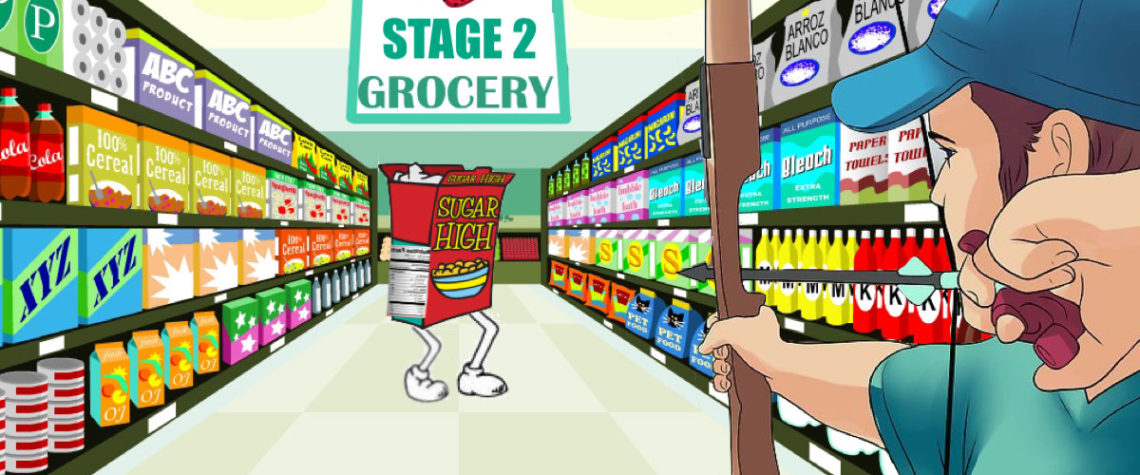The Label Games
How come we don’t have any video games based off the complex, deliciously dangerous aisles of today’s supermarket? Each row is like starting a new level, entering a land of deception and nutritional propaganda. The game would come fully loaded with excess marketing, bright colors, animated characters, dodging spills and shopping-cart road rage. Fighting off temptations (can’t miss sales) from Tony the Tiger, the Keebler Elf’s and all their processed friends. Your Goal? Return justice, aisle by aisle, exposing all of the misleading “natural”, “fresh”, and “vitamin packed” labeling, and replacing them with the stone cold nutritional facts. For on this small white rectangular box lie truths that you may not want to see….
Labels are There for a Reason
This is where you get bonus points, may I add, ones that translate into real life. By understanding what is actually in the food you’re purchasing (and making nutritious choices of course) you’ll see a boost in the way your body operates. No, not instantly, as fresh tomatoes and chickpea pasta meet the steel grate of your cart, but as you become more aware and health conscious you’ll feel the side effects. Increased Energy, More Focus, Better Sleep and more times than not Weight Loss. So start on the back of the box:

- Serving Size – Disclaimer: you’ll need to channel your inner middle school self for some math computations. The Serving Size is what all the nutrient metrics on the label are representing. The Servings Per Container, indicate how many servings are in the box. For example, to get the total caloric value contained in the sample food (on the right) you’d have to multiply 160 calories by 6 servings, giving you a grand total of 960 Calories. Let’s be real, nobody eats strictly one serving, I typical open a box and finish a box in one fluid motion. So do your homework up-front, understand the label and put it back on the shelf if it’s not going to bring you any benefits.
- Calories – For the average shopper, this is where their eyes shoot first. Calories can be deceiving, people tend to focus on how many, but really need to keep an eye on what type. Despite popular belief, A Calorie IS NOT A Calorie. Remember, this is based on a serving size so you may need some math.
- Macros – Depending on your goals your macronutrient breakdown(Carbs, Protein, Fats) may differ, and that’s fine. Here, work on LIMITING your Saturated/Trans Fats (Unsaturated Fats are good), sodium and SUGAR(not highlighted). Added sugar is a health liability, plain and simple. It has no official recommended daily value due to some great lobbying in Washington, but the American Heart Association (AHA) advises no more than 36g (males) and 25g (females) daily. To put that in perspective, one 12oz can of soda has 45g. The unsung hero here is FIBER, aim for at least 30g’s a day (the typical American only consumes about 15g). Fiber leads to all things good, aiding digestion, regulating the release of sugar, making you feel full longer and building that all-important GUT WALL.
- Micros – Micronutrients consist of all your essential vitamins and minerals, like with all things beneficial…Americans lack them. Stock up on these where you can, many times these key nutrients are added to processed foods so manufactures can claim an otherwise un-nutritious food to be nutritious. It’s best to get these naturally from fruits and veggies, they’re essential so don’t leave em’ hanging.
- The Daily Guideline – The FDA has so generously provided recommended guidelines to follow for daily nutrient consumption. Is it perfect? Absolutely not, but it’s a good place to start. As you understand what your body needs to function optimally, you can customize your plan.
- THE INGREDIENTS – Not shown in the image but my personal favorite part of the label. Who doesn’t love scanning over a list of different starches, flours, powders and sugars. Lets not forget those trusty artificial and chemical compounds, what could go wrong? Legally (in the US), all ingredients must be listed in descending order by weight, including added water. This means the ingredients listed first are most abundant. Aim to comprehend all the ingredients before putting food in your mouth. If it brings you back to high school chemistry, Put it Back!
But it’s Natural & Organic….
Lets look at some definitions of these two buzz words as it pertains to processed foods:
Natural– From the FDA Website:
The FDA has considered the term “natural” to mean that nothing artificial or synthetic (including all color additives regardless of source) has been included in, or has been added to, a food that would not normally be expected to be in that food. HOWEVER, this policy was not intended to address food production methods, such as the use of pesticides, nor did it explicitly address food processing or manufacturing methods, such as thermal technologies, pasteurization, or irradiation. The FDA also DID NOT consider whether the term “natural” should describe any nutritional or other health benefit.
Organic– From USDA Website:
- All ingredients must be certified organic.
- Any processing aids must be organic.
- Product labels must state the name of the certifying agent on the information panel.
Made With Organic -Multi-ingredient agricultural products in the “made with” category must meet these criteria:
- At least 70 percent of the product must be certified organic ingredients (excluding salt and water).
- Any remaining agricultural products are not required to be organically produced but must be produced without excluded methods
- Non-agricultural products must be specifically allowed on the National List.
- Product labels must state the name of the certifying agent on the information panel.
**May state “made with organic (insert up to three ingredients or ingredient categories).”**
**Must not include USDA organic seal anywhere, represent finished product as organic, or state “made with organic ingredients.”**
The Deciding Factor
Your running a business, it’s called “Your Life Inc.” and guess who’s making the decisions? Ultimately, how you choose to prioritize your daily 24-hours is up to You! Look at this weekly (or bi-weekly) trip to stock-up on energy as an investment. Your providing nourishment to the most valuable assets you’ve got. Here are some tips and tricks to take your game to the next level:
- Work the outside of the Store (Produce, Lean Meats) – These areas tend to have the Highest Nutrient /Least Processed options.
- Stock up on Fruits and Veggies (They’re the best source of Natural Fiber and Vitamins)
- Investigate your Processed Foods
- No Added Sugar
- High Fiber (3g per serving or more)
- Less than 5 Ingredients (all of which you can pronounce)
- Go Organic Where Possible
Nothing new here, I’ll add the common (yet true) notion that change won’t happen overnight, but over Many Nights. Just like playing a video game, adversity hits at unexpected moments, it’s all about being in a position to overcome, win, and move on to the next level. Everyday is a new opportunity.





